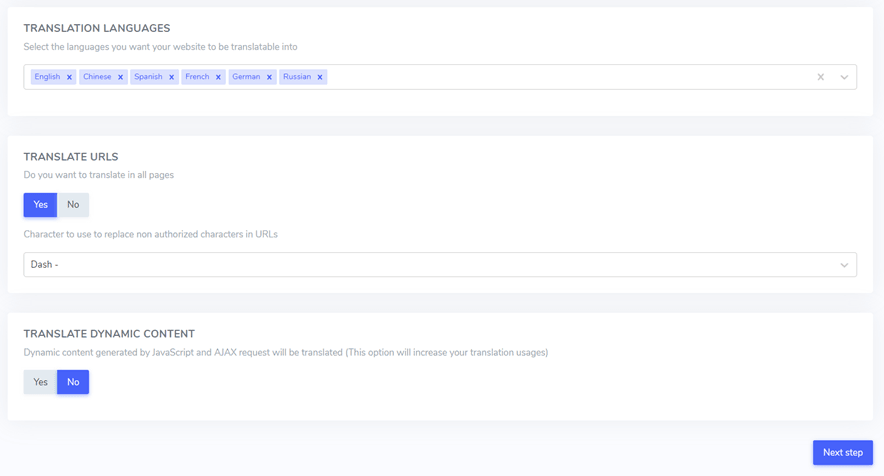Implementing automatic translation on Kirby CMS can be a strategy for businesses aiming to connect with diverse language audiences. A multilingual website is not just an added feature but a crucial element for maintaining competitiveness and exploring new market opportunities.
By integrating automatic translation into your Kirby-powered site, you can efficiently create and maintain multilingual content, significantly reducing time and resource investments while ensuring a consistent, high-quality user experience across various languages. This guide will walk you through implementing automatic translation on Kirby CMS, provide examples of websites, and provide step-by-step instructions.
Why should you implement automatic translation on Kirby CMS?

Here are four key reasons you should implement automatic translation on Kirby CMS.
- Expanded Global Reach: By offering your website content in multiple languages, you can connect with a worldwide audience. For example, if you operate an international e-commerce site, automatic translation into various languages allows you to tap into new markets and attract customers who may not be fluent in your primary language.
- Enhanced User Engagement: When visitors encounter content in their preferred language, they’re more likely to engage with it, leading to lower bounce rates. A seamless multilingual experience can keep users on your Kirby-powered site longer, increasing the chances of conversion or desired actions.
- Boosted Conversion Rates: Studies show that people are more inclined to purchase or take desired actions when presented with content in their native language. Implementing automatic translation on your Kirby CMS can increase conversion rates and drive more sales or lead generation from diverse language markets.
- Improved SEO Performance: Translating your Kirby website content into multiple languages can significantly enhance your search engine optimization efforts. Search engines favor localized content, increasing the likelihood of your website appearing in relevant search results for international audiences, thereby driving more organic traffic.
Examples of implementing multilingual website Kirby CMS
According to trends.builtwith.com, dozens of sites are built using Kirby CMS. Therefore, this time, we will discuss some examples among them to give you an idea of whether you are considering creating a multi-language Kirby CMS site.
Original Mockups

Original Mockups is a website that offers high-quality mockups for designers to showcase their work. Their website, which could be built with Kirby CMS, provides content in both English and Spanish (Beta). This multilingual approach allows the website to cater to a broader audience of designers from different regions, presenting their mockup products and services in the users’ preferred language.
Also, the website at the bottom of the page allows users to select between English and Español (Beta). This feature enables seamless navigation between languages, enhancing the user experience for English-speaking and Spanish-speaking visitors. The multilingual setup in Kirby CMS would allow the management and presentation of their content, including product descriptions, pricing information, and support documentation, in multiple languages while maintaining a consistent design and user interface across all language versions.
OBS Project

OBS Project, the creator of OBS Studio, utilizes Kirby CMS to power its multilingual website. Built with Kirby CMS, OBS Studio’s website offers content in multiple languages to cater to a global user base of content creators and streamers.
At the bottom of the page, we can see a comprehensive language switcher featuring 15 different language options, including Čeština, Dansk, Deutsch, Español, Euskara, Suomi, Français, Magyar, 日本語, 한국어, Português do Brasil, Русский, Svenska, Türkçe, Українська, and 中文(简体). This multilingual approach allows the OBS Project to effectively communicate with users worldwide, providing documentation, download instructions, and community resources in their preferred languages.
How to implement automatic translation on Kirby CMS
After examining examples of multilingual websites created with Kirby CMS, we will explore how to implement automatic translation using an automatic translation service. Many services can translate websites quickly and easily with just a few configuration steps. One such service is Linguise.
Linguise integrates with various CMS platforms and web builders, including Kirby CMS. Here are the steps to install Linguise automatic translation on Kirby CMS.
Step 1: Register your Linguise account
The first step is to ensure your Kirby CMS website is ready for translation. You need access to the Kirby CMS admin dashboard to install Linguise automatic translation on a Kirby CMS website.
Next, create a free Linguise account and add your website’s domain. You can use the 30-day free trial before deciding on a subscription plan.
Step 2: Add domain website Kirby CMS
After creating a Linguise account, access the dashboard to add your Kirby CMS website domain. Click on “Add domain” and fill in the following fields:
- Account
- URL
- Platform used (Kirby CMS)
- Default language
- Translation languages
- Translate URLs
- Dynamic content translation


Step 3: Upload & connect the Linguise script
The Linguise translation script needs to be uploaded to the server where Kirby CMS is installed. You can download it here.
Once the script is downloaded, unzip it and upload it to the root folder where Kirby CMS is installed.
- Ensure it’s placed at the root level of your website (where your Kirby CMS files are located).
- Ensure the folder retains its default name, “linguise.”

Next, you’ll need to copy the Linguise API key into the `Configuration.php` file you uploaded to your server. Edit the file and paste your API key between the single quotes, replacing the text `REPLACE_BY_YOUR_TOKEN`.

Step 4: Setup the the Kirby CMS URLs rewriting
By default, URL rewriting is active in Kirby CMS. If it’s not, you can activate it through your hosting provider.
To configure URL by language, add the following code to your `.htaccess` file after the line `RewriteEngine on` in the default Kirby CMS `.htaccess` file:
<IfModule mod_rewrite.c>
RewriteEngine On
RewriteRule ^(af|sq|am|ar|hy|az|eu|be|bn|bs|bg|ca|ceb|ny|zh-cn|zh-tw|co|hr|cs|da|nl|en|eo|et|tl|fi|fr|fy|gl|ka|de|el|gu|ht|ha|haw|iw|hi|hmn|hu|is|ig|id|ga|it|ja|jw|kn|kk|km|ko|ku|ky|lo|la|lv|lt|lb|mk|mg|ms|ml|mt|mi|mr|mn|my|ne|no|ps|fa|pl|pt|pa|ro|ru|sm|gd|sr|st|sn|sd|si|sk|sl|so|es|su|sw|sv|tg|ta|te|th|tr|uk|ur|uz|vi|cy|xh|yi|yo|zu|zz-zz)(?:$|/)(.*)$ linguise/linguise.php?linguise_language=$1&original_url=$2 [L,QSA]
</IfModule>
You can now load all your translated pages using the URL: “www.shop.com/fr/”.
Step 5: Activate & customize the language switcher
The Linguise JavaScript link must be loaded on all your Kirby CMS pages to display the language switcher with flags and alternate URLs in your HTML headers for SEO purposes.
To get the script link, go to the domain settings on the Linguise dashboard and copy the script link.

The easiest way to load this code in Kirby CMS is to add it inside your website’s header.php or <head> code.
Here’s how to set it up.
- Access the root folder of your website.
- Navigate to site > snippets > header.php.
- Edit the header.php file to include the script link in the header section, as shown below.

Now, after setting it up, you can preview the language switcher’s appearance. Here’s an example demonstrating how Kirby CMS looks when automatically translated using Linguise’s automatic translation service.

Automatic translation of your Kirby CMS with Linguise
Linguise offers a seamless integration of automatic translation into your Kirby CMS website. As a leading translation service, it supports over 80 languages and integrates with over 40 CMS platforms, including Kirby CMS. This integration simplifies making your website multilingual, ensuring a smooth user experience.
Support 100% multilingual SEO translation

With Linguise, you can enhance your website’s visibility in search engines through multilingual SEO features. It helps generate multilingual sitemaps, create hreflang codes and tags, set up canonical URLs, and translate URLs and meta descriptions. These features improve your site’s search engine rankings and accessibility for users in different languages.
Front-end live editor for translations
Linguise provides a front-end live editor that allows you to adjust translations as needed quickly. This tool helps you make quick changes and ensures translations are accurate. Additionally, you can collaborate with professional translators to maintain contextual and cultural precision.
Automatic translation exclusion rules

To handle translation challenges, Linguise offers exclusion rules to retain or omit specific terms that may not translate well. You can set rules to ignore specific text, inline content, or certain pages, ensuring clarity and accuracy in your translations.
Dynamic translation feature
Linguise’s dynamic translation feature ensures that content generated or loaded dynamically—such as through JavaScript or AJAX—is translated effectively. This includes elements like checkout processes and popups. Simply activate the dynamic translation toggle to manage this content effortlessly.
Conclusion
Implementing automatic translation on your Kirby CMS website can significantly expand your reach, improve user engagement, and boost conversion rates. Using Linguise, you can effortlessly manage multilingual content, ensuring a seamless experience for users across different languages while optimizing your SEO efforts.
Linguise offers robust features like front-end live editing, dynamic content translation, exclusion rules for specific terms, and comprehensive SEO support. These capabilities make it an excellent choice for integrating automatic translation with Kirby CMS.
Don’t hesitate—register for a Linguise account today and start transforming your Kirby CMS website into a multilingual powerhouse.





